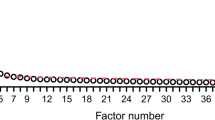Abstract
This study examined the factor structure of the Beck Depression Inventory—II (BDI-II) in a sample of 127 individuals referred by their primary care physicians. Using exploratory factor analysis with oblique rotation, a 2-factor model appeared to be the most parsimonious representation of the data. The rotated factors accounted for approximately 53% of the variance. Consistent with previous research, the first factor was interpreted as a somatic–affective dimension and the second factor reflected a cognitive dimension. The correlation between these 2 factors was .79. It appears possible to divide the BDI-II into subscales to facilitate interpretation in medical patients.
Similar content being viewed by others
References
Aikens, J. E., Reinecke, M. A., Pliskin, N. H., Fischer, J. S., Wiebe, J. S., McCracken, L. M., et al. (1999). Assessing depressive symptoms in multiple sclerosis: Is it necessary to omit items from the original Beck Depression Inventory? Journal of Behavioral Medicine, 22, 127–142.
Arnau, R. C., Meagher, M. W., Norris, M. P., & Bramson, R. (2001). Psychometric evaluation of the Beck Depression Inventory–II with primary care medical patients. Health Psychology, 20, 112–119.
Beck, A. T., Steer, R. A., & Brown, G. K. (1996). Beck Depression Inventory manual (2nd ed.). San Antonio, TX: Psychological Corporation.
Clark, D. A., & Steer, R. A. (1994). Use of nonsomatic symptoms to differentiate clinically depressed and nondepressed hospitalized patients with chronic medical illnesses. Psychological Reports, 75, 1089–1090.
Coyne, J. C., Schwenk, T. L., & Fechner-Bates, S. (1995). Nondetection of depression by primary care physicians reconsidered. General Hospital Psychiatry, 17, 3–12.
Dozois, D. J. A., Dobson, K. S., & Ahnberg, J. L. (1998). A psychometric evaluation of the Beck Depression Inventory–II. Psychological Assessment, 10, 83–89.
Eisenberg, L. (1992). Treating depression and anxiety in primary care: Closing the gap between knowledge and practice. New England Journal of Medicine, 326, 1080–1084.
First, M. B., Spitzer, R. L., Gibbon, M., & Williams, J. B. W. (1998). Structured Clinical Interview for DSM-IV Axis I Disorders—Non-Patient Edition (SCID-I/NP, Version 2.0—8/98 revision). New York: Biometrics Research Department, New York State Psychiatric Institute.
Griffiths, S., Boddy, J., Woodward, T., & Iverson, G. L. (2001). Factor structure of the Beck Depression Inventory-II in a community sample. Paper presented at the 62nd Annual Convention of the Canadian Psychological Association, Laval University, SteFoy, Quebec.
Steer, R., & Clark, D. (1997). Psychometric characteristics of the Beck Depression Inventory-II with college students. Measurement and Evaluation in Counseling and Development, 30, 128–136.
Whisman, M. A., ElPerez, J., & Ramel, W. (2000). Factor structure of the Beck Depression Inventory—Second Edition (BDI-II) in a student sample. Journal of Clinical Psychology, 56, 541–551.
Zung, W. W., Broadhead, W. E., & Roth, M. E. (1993). Prevalence of depressive symptoms in primary care. Journal of Family Practice, 37, 337–344.
Author information
Authors and Affiliations
Rights and permissions
About this article
Cite this article
Viljoen, J.L., Iverson, G.L., Griffiths, S. et al. Factor Structure of the Beck Depression Inventory—II in a Medical Outpatient Sample. Journal of Clinical Psychology in Medical Settings 10, 289–291 (2003). https://doi.org/10.1023/A:1026353404839
Issue Date:
DOI: https://doi.org/10.1023/A:1026353404839




